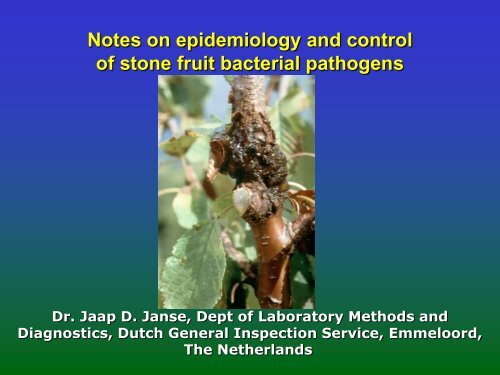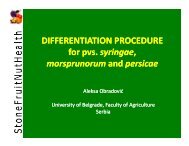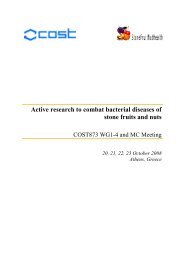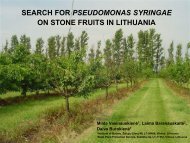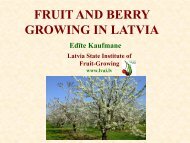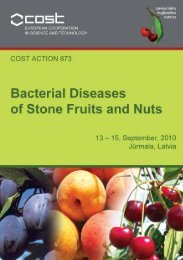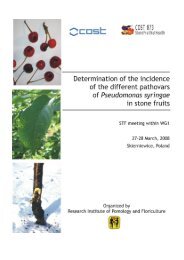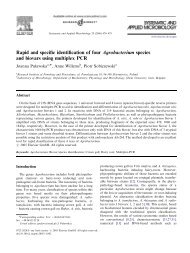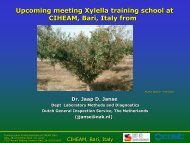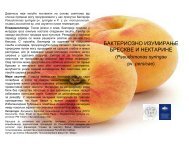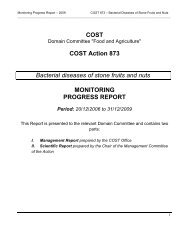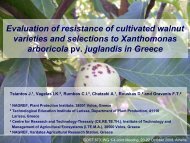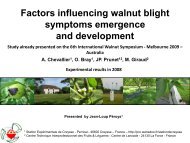Of Stone Fruit Bacterial Pathogens - Cost 873
Of Stone Fruit Bacterial Pathogens - Cost 873
Of Stone Fruit Bacterial Pathogens - Cost 873
- No tags were found...
You also want an ePaper? Increase the reach of your titles
YUMPU automatically turns print PDFs into web optimized ePapers that Google loves.
Notes on epidemiology and controlof stone fruit bacterial pathogensDr. Jaap D. Janse, Dept of Laboratory Methods andDiagnostics, Dutch General Inspection Service, Emmeloord,The Netherlands
Agrobacterium tumefaciens -stone fruitsCrown gall or root knot on• Infested soil, Infected plant material combinedwith wounding during cultivation.• Nematodes may play a role. No seedtransmission.• In areas where biovar 2 occurs, biologicalcontrol with K84 or K1026 can be very effective.
Brennaria (Erwinia) nigrifluens - Shallow bark canker ofwalnut• Originally reported from USA in 1957. Much laterfrom Italy and France (2004).• Oozing shallow cankers will be main cause ofspread.• In Italy changed cultural practices (moreintensive cultivation, higher fertilization) led toincrease in these type of cankers.• Isolated from choanal slit of parrot?!
Brenneria (Erwinia) rubrifaciens - Deep bark canker ofwalnut.• Reported from USA 1967.• On trees older than 15 years, symptoms similarto bleeding of horse-chestnut caused by aP.syringae type bacterium.• Dark brown to black streaks along the innerbark and outer sapwood of trunks and mainbranches.• Mechanical harvesters are the maintransmitters, where there is no mechanicalharvesting disease not important• Spreading by budwood is also possible• Birds feeding on sap are suspected, but thebacterium could not be isolated from them
Pseudomonas amygdali - Bacteriosis or <strong>Bacterial</strong>hyperplastic canker of almond• Reported from Greece and Turkey. Italy at risk• Natural and artificial infection only sucessful onalmond.• Perennial cankers on branches and twigs,usually at leaf scars, that show a lot ofhyperplastic activity (swelling). Girdling causeddeath of branches.• Leaf scars are likely places of infection, justafter leaf fall and in wet conditions.
Pseudomonas avellenae -Canker or decline of hazelnut• Reported from Greece in 1976, later in centralItaly (2001). Turkey at risk• Mode of transmission not really known,planting material may be important.• Cultivars found with some resistance• Related bacteria P.s. pv. coryli and P.s. pv.syringae, causing bacterial twig dieback ofhazelnut in C. Italy and Sicily and S. Germany
Pseudomonas syringae pv. avii - Canker of wild cherry• Reported from France, 2003. Very much relatedto Pss. Also pathogenic to cultivated cherry.• Strains from Psa, Pss and Pmp studied inFlanders, Belgium (Dr. M. Steenackers)
Pseudomonas syringae pv. castaneae - Canker ofchestnut (Castanea)• Reported from Japan in 1989 from Castaneacrenata• Cankers formed in spring on twigs that causebud death and leaf blight and small galls onshoots, petioles, midveins and flower clusters• Related to P. syringae pv. eriobotryae, causingstem canker of loquat (Eriobotrya japonica –Rosaceae)
Pseudomonas syringae pv. morsprunorum - Bacteriacanker of stone fruits, blossom blast, gummosis, leaf spotof stone fruits• Canker phase on shoots, branches and limbsmost important.• Leaf scar infection and dispersal by rain splash.Hail storms favor the leaf spot phase.• Copper resistance not yet observed• Field resistance of P. avium, P. cerasus and P.avium × P. cerasus, towards bacterial cankerlow, high and very high, respectively• Two races (based on phage typing) with somehost specificity can be discriminated with rep-PCR. Ecological significance?
Pseudomonas syringae pv. persicae (EPPO Quarantine ListA2) - Dieback/canker on nectarine and peach• First observed in France 1967 and proved to bepresent also in New-Zealand in 1988 where alsoPrunus salicina (Japanese plum) was infected.Once isolated in the UK from P. cerasifera• Pruning wounds and frosty weather arepredisposing factors.• Leaf scar infection from epiphytic leafpopulations in autumn.Photo’s : INRA Luisetti, France
Pseudomonas syringae pv. syringae - Bacteria canker orblast of stone and pome fruit, apoplexy of apricot, deadbud of cherry, twig dieback in hazelnut• Pss can overwinter in cankers and on/ininfected leaves and buds in an epiphytic orlatent form, possibly on weeds and nonsusceptiblehosts• INA-positive, associated with (night) frosts• Infection stops when weather becomes warmand dry• Trees may recover when carefully pruned andenvironmental conditions are controlled (carefulfertilization, water household, soil pH above 6etc.
Pseudomonas syringae pv. syringae - Bacteria canker orblast of stone and pome fruit, apoplexy of apricot, deadbud of cherry, twig dieback in hazelnut• Preventive copper and/or antibiotic sprays(when permitted) in spring and autumn.However: resistance may develop and hasdeveloped, also in Europe.• When pruning preferably in the dry period andalways disinfect tools, close wounds with aprotective agent (preferably containing a coppercompound such as copperoxychloride)• Use of healthy budwood, seed, trees – use ofcertification schemes• Insect control when vector transmitted
Xanthomonas arboricola pv. pruni (EPPO Quarantine ListA2) - <strong>Bacterial</strong> leaf spot, shot-hole, black spot of almond,apricot, nectarine, peach, plum and prune• In Italy since 1920, Romania 1941, Bulgaria,Slovenia, in France since 1995.• Peach, nectarine: leaf phase importantoverwintering in small twig cankers. Cankerformation not so important• Plum and apricot: hold-over cankers also on 2-3year old branches important and often quitedamaging• Cherry: fruit infection more important• Temperatures 15-28C, heavy rain and wind inspringtime favour epidemics• Apparently less important on almond• Risk for NW Europe when climate changestowards warmer will persist
Xanthomonas arboricola pv. corylina (EPPO QuarantineList A2) - <strong>Bacterial</strong> blight of hazelnut• Reported from USA in 1913. Yugoslavia (plantingmaterial?), 1956, Italy 1969, later in Algeria, Denmark,France, Netherlands, Russia, Slovenia, Spain,Switzerland, Turkey, UK and S.Germany• Rain splash, pruning tools and planting material.• Epiphytic phase, may survive several months in/on(fallen) diseased leaves• Bud infection and overwintering more important thancankersPhotos: poschenrieder and gardan
Xanthomonas arboricolapv. juglandis -blight or black spot of walnutWalnut bacterial• Bacteria survive in buds and catkins, in fruitlesions, to a lesser extent in cankers on twigs.• Dispersal by large walnut aphid Chromaphisjuglandicola and mites (walnut leaf gall mite,Eriophyes erineus).• Wet weather in spring favors diseasePhoto: INRA, gardan
Xanthomonas species (probably translucens) -dieback or decline• Described from Australia in 2001 from pistachio• Dieback of twigs, internal staining of tissues,lesions on trunk, limbs and branches, resinexudation and tree death. No fruit infection.• Bacterium moves quickly in new tissue but thandies and plants may recover• Pruning tools could transmit the disease. Othertransmission still unknown• Planting material could be a risk• Copper sprays not very effective when usedafter artificial infectionPistachioPhoto: Univ. of adelaide, au
Xylella fastidiosa (EPPO Quarantine List A1). - Leafscorch of almond, peach, pecan, plum and prune, Phoneydisease of peach• Vector transmitted, on grapevine Cicadella viridis,Philanaeus spumarius (meadow spittle bug) in SEEurope.• On peach Homalodisca coagulata, H. insolita,Oncometopia orbona, Graphocephala versuta inN.America.• Risks for plum (plum leaf scald) could be important.• On peach not very damaging (fruit size reduction).Prunus salicina


